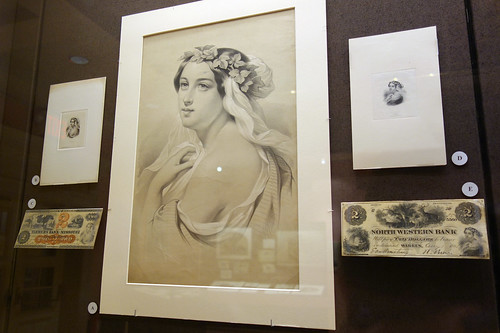
PREV ARTICLE
NEXT ARTICLE
FULL ISSUE
PREV FULL ISSUE
ARTICLE PROFILES IMAGES OF VALUE EXHIBITThis article from the Hyperallergic blog has some great photos of the Images of Value: The Artwork Behind U.S. Security Engraving, 1830s–1980s exhibit at the Grolier
Club. See the complete article online for more. -Editor
 Before the United States produced the Hudson River School or paintings of the American Frontier, the new country proved its artistic might on banknotes. Images of Value: The Artwork Behind U.S. Security Engraving, 1830s–1980s at the Grolier Club chronicles 150 years of this history, with over 250 paintings, drawings, etchings, banknotes, and stock certificates, along with currency from 15 countries. Mark D. Tomasko, who collected most of the works on view, notes in an introduction that security engraving “was one of the first arts in which the United States became a world leader.” Tomasko explained to Hyperallergic that his interest in security engraving spawned from collecting coins, which he started doing at the age of 10. “Within four or five years, I became interested in banknotes.” At the time, “three different kinds of paper money were circulating”: green-seal federal reserve notes that survive today, red-seal US notes, and blue-seal silver certificates. “Still later, when my grandmother gave me some stock certificates of the Marmon Motor Car Company [1920s–30s], I discovered securities, as they were the largest format for banknote engraving. By the late 1960s I was interested in the engraving on the banknotes and securities — who did it, how was it done, and where the artwork came from.” There were several factors that contributed to the success of this financial fine art in the US, including the quality of engraving firms in Philadelphia and New York as well as a system that allowed nearly all American banks to issue their own notes. And the more expertly executed the security engraving, or “vignette,” the harder to counterfeit the note or bond. The exhibition at the Grolier Club begins with early 19th-century pastoral scenes, including work by Asher B. Durand, who worked in banknote art before concentrating on landscape paintings, and progresses up to the 1960s–80s, when artists like Robert Lavin were modernizing allegorical figures to represent new technology and industry. To read the complete article, see:
To read the earlier E-Sylum articles, see:
Wayne Homren, Editor The Numismatic Bibliomania Society is a non-profit organization promoting numismatic literature. See our web site at coinbooks.org. To submit items for publication in The E-Sylum, write to the Editor at this address: whomren@gmail.com To subscribe go to: https://my.binhost.com/lists/listinfo/esylum All Rights Reserved. NBS Home Page Contact the NBS webmaster 
|